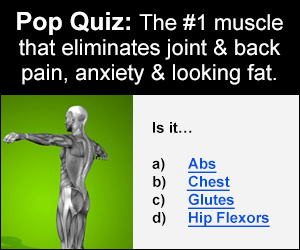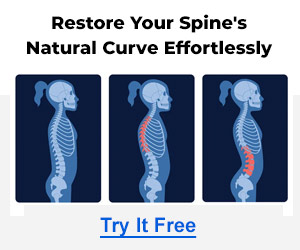Unfortunately, shedding unwanted fat is a lot more complicated than just cutting back on calories and adding in a few extra cardio sessions each week.
The problem is that our genetic programming gets in the way, making getting rid of fat a lot more complicated than we’d like.
When we start to cut calories and burn more energy our bodies think that we’re facing a food shortage.
In response, it releases a flood of hormonal responses that are designed to conserve energy and make sure we’ve got fat reserves to draw on for the upcoming ‘famine.’
These hormonal responses are what stand in the way of our fat loss goals.
There are three in particular that inhibit fat loss–estrogen, insulin and cortisol.
When we do the things we do to shed unwanted fat, it triggers the release of these hormones.
And when released, each of these tells the body to increase residual fat storage, especially around the waist area.
The good news though is that we can ‘fight hormones with hormones’ and manipulate our metabolic systems to overcome these fat loss roadblocks.

Mastering Hormonal Strategies for Fat Loss
The secret to this strategy is identifying the nemesis for each ‘bad’ hormone–or in other words, the ‘good’ hormone that does the opposite of what the ‘bad’ hormone does.
For example, testosterone is the ‘opposite’ of estrogen. Testosterone is the male sex hormone and estrogen is the female sex hormone.
To combat the fat storage effects of estrogen, we want to increase the amount of testosterone our bodies release.
There are several ways you can naturally increase the amount of testosterone the body releases.
One of the best ways to accomplish this is by lifting weights.
In particular, increasing training density has proven to be an excellent technique to stimulate testosterone production.
Training density refers to the amount of work you perform within a given timeframe.
You can increase training density by lifting more weights, performing more repetitions or by reducing the rest periods between sets.
To fight the stubborn fat around the mid-section of the body, you can really increase training density through a modified circuit training technique.
A key difference between this and other types of circuit training is that here, instead of focusing on doing a certain number of reps, you perform as many reps as you can within a certain time period for the first set.
Then, you increase both the weight and the number of reps you perform for the second set.
Similarly, there are training techniques you can employ to combat insulin and its impact on body fat storage.
Here, training techniques focus on increasing insulin sensitivity and boosting Insulin-Like Growth Factor 1 (IGF-1), which counters the effects of insulin.
Dynamic training–which is based on combination movements–is particularly effective at boosting the amount of IGF-1 in the bloodstream.
Higher amounts of IGF-1 negates insulin resistance and increases the body’s fat-burning capacity.
We can also combat the fat gaining effects of cortisol by increasing the amount of Growth Hormone (GH) our bodies produce.
GH is the single most effective compound your body produces to affect both fat loss and muscle gain.
The more GH the body produces, the more fat you burn and the more lean muscle mass you add.
Like the other two fat-fighting hormones, certain training techniques stimulate the production of GH.
Lactic acid training is one technique that is especially effective.
Lactic acid is what causes the ‘burn’ you feel when you train your muscles really hard.
As annoying as that feeling may be, it does trigger the release of cortisol- and fat-fighting GH.
You can boost the release of lactic acid by lifting very slowly and then quickly (but carefully) returning to the starting position.
Another way to increase GH production and diminish cortisol production is by sleeping.
Yes, a good night’s rest triggers the production of GH while simultaneously diminishing the production of cortisol.
So there you have it–three fat-fighting training techniques from Roman’s Final Phase Fat Loss at your disposal.
Include these in your training arsenal and you’ll be able to fight hormones with hormones and win the battle against stubborn fat, once and for all.
Attention Men and Women: If you’ve been struggling to lose those last 10 to 15 pounds, battling with slow fat loss, OR suffering from nagging “problem area” fat storage in your lower body, love handles, or belly this could be the most important web page you ever read. http://www.finalphasefatburning.com



















































































i need the complete the body workout routine
I just want you to know that I have never bought any of your programs or services that you have offered because of financial reasons but I sure am glad you give away free information here and there. I really find alot of stuff on here interesting and I must say this is the best thing I think you have ever done. I am in my final phase myself in fat loss with only a small bit of fat left next to my obligues and I am going to try your dynamic lifting advice and see if thats the trick. Thanx Robert
ok so how do we incorporate these fat specific exercises into the workout regimen we’re already on…im on phase two of the program, and have gained some muscle mass a little bit although my weights have gone down a lil bit. but how would i involve this into phase two of the program? should i do some of these exercises instead of some that im already doing or what?
Finish Phase 2 and than you can use Roman’s Final Phase Fat Loss as phase 3 of your Lean Hybrid Muscle RELOADED program. Mike
Great overview, especially the ideas for increasing test levels and the release of cortisol. As I’m currently in the process of trying to cut my body fat percentage down, ever little bit of these type of “tools” helps.
How long would you speculate that it takes for your body to adapt to utilizing stored fat for energy to power through workouts?